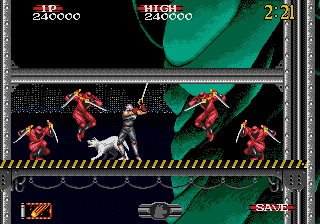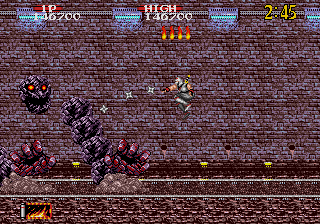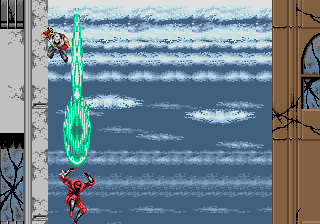 |
Shadow Dancer Release year - USA:1990 Company: Sega System: genesis Genre: Platformer Players: 1 |
Review by: PrimeOp
| Sega's Shadow Dancer for the Genesis may share a name with the second Shinobi arcade game, but is a brand new adventure instead of a port. |
| Once again, an army of villains attempt to bring the world to it's knees with it's vast array of warriors. The group known as Union Lizard takes over New York and takes hostages to use as human shields. They're just evil like that. In other words, it is time for Jo Musashi (or in the case of the Japanese version, his son Hayate) to emerge from the ever-cool shadows with a fist full of shuriken and a hand full of ninja-to to deliver true ninja justice in the grand Shinobi manner. Accompanying Musashi is a dangerous, faithful hound named Yamato who aids his master with his deadly arts. We'll talk about him later. The gameplay follows the same mold as the arcade as well as the original Shinobi title. While having infinite shuriken (without any sound test tomfoolery), you don't have a health bar and will be killed by touching enemy weapons, hazards and a few enemies themselves. Plus, you have the nifty ninja low walk to dodge most projectiles. Finally, no Shinobi game is complete without ninjitsu magic and this one is more like the original Shinobi's random magic that damages all foes unlucky enough to be on-screen. However, some bosses can block or avoid those attacks, so timing is still a huge factor. |  For once, the ninja drones are some of the most dangerous enemies in the game. |
 Like any good Shinobi game, you'll need to figure out the pattern and the weak point of many strange, strange bosses. As always, catching the rhythm of when they leave themselves open is an absolute must. | Your main goal is to rescue all the hostages before heading towards the exit with occasional blonde female captives giving a power-up to your shuriken. Many enemies have blocking techniques that make them a bit more difficult to deal with. That's where Yamato comes in. Hold the attack button until the his doggy-meter is full. Wait for the enemy to drop their guard (gunmen reloading pistols) and release the button to release the hound. As Yamato chews on the enemy's arm, you can cut down the helpless villain. Yamato can be hurt by attacks and will shrink into a pup until you rescue another hostage. Each of the first two stage sections are like this with the third being a boss battle that you must wage without Yamato's help. After that, you get to play a bonus round that you have a fair chance of racking up some extra lives. |
| As I said earlier, most of the levels and enemies of this game differ from the arcade version with a few crossovers between the two. Most of the new Union Lizard enemies in this game are more like freaky comic book villains than their arcade Asian Dawn counterparts. The new drones look like spandex-clad sentai cannon fodder (which they are here) and even has a green version of the Spidey-like floorcrawlers. Being a Shinobi game means that you've got to have some crazy bosses and this game does NOT disappoint one bit. Along with the manditory 'Lobster' 1st boss, you'll have to deal with everything from a giantess armed with large buzzsaws to a creature that is merged with a brick wall. Most of the changes from the arcade were better, although the arcade stages seemed to make more logical sense as a path with how they linked up. Of course, I'd instantly trade the arcade's logic for the first stage which features a burning cityscape where fire erupts from the sewers. Now THAT is how you start off a game! I think the music of both are equally good with the Genesis version being a bit funkier complete with 'Art of Noise'-like vocal hits. |  This bonus round is easy if you know the easiest place to catch these enemies. |
| This game doesn't reach the heights of Revenge of Shinobi or Shinobi III in terms of all-out greatness, but is still solid enough to be worthy of the Shinobi brand. Just don't expect a straight port of the arcade game. This one just 'feels' more like a console title than a port of the arcade version would've been. |
Return to top of the top of the page
